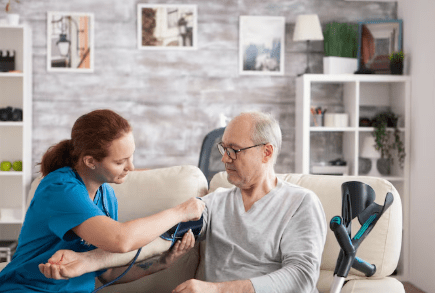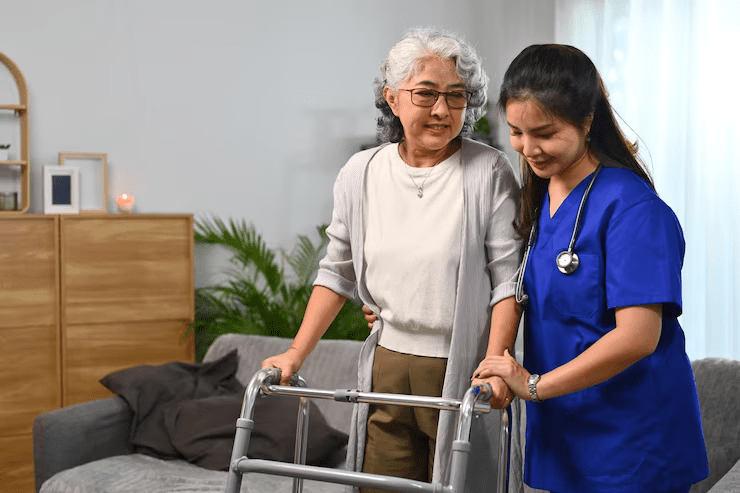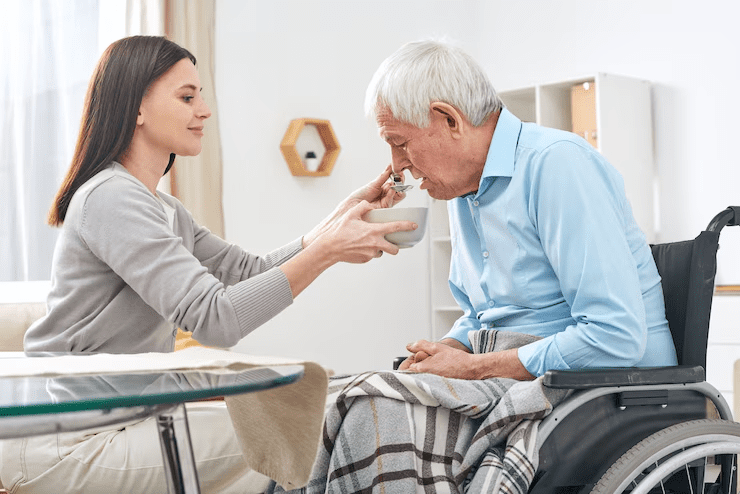If you’ve ever found yourself wondering, “What exactly does a home health care person do?”, you’re not alone. As families in Sunrise and throughout the United States seek solutions to caring for aging relatives or family members getting over an illness, Sunrise home health care has been an asset and a must-have support mechanism.
To put it in one word, a home health care professional helps people remain safely and comfortably at home. What does that mean, though? We have explained it in layman’s language, no medical terms, no big words. Just honest help, for real people.
Daily Help That Makes a Big Difference
A home health care individual is more than a caregiver. They are a friend, an assisting hand, and even a lifeline. They assist individuals who are no longer able to do everything on their own, due to age, injury, illness, or disability.
Here’s a closer examination of what they do:
Personal Care
This involves assisting with:
- Bathing
- Dressing
- Grooming
- Using the toilet
- Moving safely around the house
It’s all about dignity. Most people prefer to remain independent for as long as they can, and a home care worker assists them in doing so safely and hygienically.
Health Monitoring
They aren’t physicians or nurses (except perhaps if they are licensed for medical procedures), but they do monitor how the individual is functioning on a daily basis. This may involve:
- Reminding them to take medication
- Monitoring for signs of pain or changes in health
- Reporting problems to family or healthcare professionals
In Sunrise, home health care aides frequently serve as eyes and ears for family members who can’t be present daily.
Light Housekeeping
Consider how difficult it is to live well in a cluttered or dangerous home. A home care individual assists with such tasks as:
- Washing dishes
- Sweeping and mopping
- Doing laundry
- Making beds
They make things clean, tidy, and secure. It’s not deep cleaning, but it contributes to a healthy household.
Emotional Support is Huge
It’s not all physical work. One of the largest things a home health care individual offers is companionship.
Loneliness exists, particularly among the elderly. A smile, someone to talk to, someone who listens… that is all it takes.
These are some things they can do:
- Drinking tea and chatting
- Walking together
- Playing board games or cards
- Taking them to the doctor or store
- These little moments make people feel valuable and valued.
Personalized Care Plans
Not everyone needs the same kind of help. That’s why home health care is flexible. Caregivers often follow a care plan designed around:
- The person’s health conditions
- Family input
- Doctor’s recommendations
- Daily routines and preferences
Whether it’s a few hours a day or round-the-clock care, Sunrise home health care professionals can adjust to what works best for your family.

Real Help For Real Families
Home health care caregivers aren’t only a blessing to the individual they’re taking care of, they’re life savers for families as well.
Now, let us be honest. Balancing your personal life, career, children, housework, errands, and now you have to take care of a sick parent or an ill loved one at home? It’s a lot.
That’s where services like Wisdom Senior Care come in.
We provide:
- Companionship services
- Transportation support
- Home management
- Personal care
In Sunrise or elsewhere, we want to make life easier for seniors and their loved ones, and so you are not trying it alone.
How It All Works
If you’re coordinating care for a loved one, you may be working with several pieces:
- A home health care aide for daily support
- A nurse or therapist for medical issues
It’s sort of assembling a team around your loved one, one that can enable them to remain at home and live well there.
And long-term planning. Other families are taking the initiative of long-term care insurance, which can perhaps finance services like home care in the future.
FAQs
- What kind of service can I get from a Sunrise home health care professional?
A Sunrise home health care professional offers many services to support seniors or individuals requiring assistance with daily activities at home. Such things are personal care like bathing, grooming, dressing, medication reminder, companionship, even light physical therapy or mobility assistance with professional supervision. Others are also involved in doing errands, buying groceries, and light housekeeping. It is just about the provision of loved ones with the possibility to live safely and comfortably at home, yet be independent.
- Is Sunrise home health care the same as hiring a nurse or a doctor?
No, not really. A Sunrise home health care staff member is generally not a doctor or registered nurse unless otherwise stated. Although certain home health aides may be certified nursing assistants (CNAs), they will not usually administer medical treatment or diagnoses. Instead, they offer simple day-to-day nursing, which is more about dignity, comfort, and quality of life than medical treatment. As an example, they may help the clients with personal hygiene or cooking, but will not operate or change the medication without the guidance of a nurse.
- Can a home health care individual assist with housework as well?
Yes. One of the best values is assistance with light household duties. Numerous clients seek home health care workers who can aid with general home maintenance, such as doing laundry, managing medications, cleaning, or cooking. Now, if your loved one requires heavy cleaning, a professional residential cleaning firm in Placerville or wherever you are may be more suitable. Home health aides are more concerned with making the home habitable and safe than doing heavy cleaning.
In Conclusion
So what does a home health care individual do?
They can help with the fundamentals, personal care, eating, and some light housework. They are the sources of emotional support and companionship. They give assurance to families.
Bottom line, they make daily living better for individuals who prefer to live safely in their own homes.
At Wisdom Senior Care, we’re here to be part of your family’s support system. In the form of short-term care or long-term care, we carry with us as experience and as heart into every home we go. We have well trained, caring and willing to lend a hand caregivers.
And to plan ahead, you should consider such an option as long-term care insurance, so that your loved ones can get good care without being worried about the costs.
Wish to know more about home care in Sunrise or seek the appropriate support system? Contact us; we are here to assist you all the way.

As you’re looking into home health care in Burlington NC, one of the things on your mind may be, “Will Medicare pay for part or all of it?” And it’s a good question—because let’s be honest, home care isn’t a luxury. It’s about keeping our loved ones safe, healthy, and happy.
But it can add up fast.
That’s where Medicare enters the picture. The idea of having help and getting some of it paid for? That sounds ideal. But here’s the catch: Medicare only covers certain things under certain conditions. It’s not a blanket yes—or a definite no.
Let’s break it all down so you’re not left guessing.
What Exactly Is Home Health Care?
Before diving into coverage, let’s get clear on what home health care means.
It’s not a drop-in, either. Home health care usually refers to professional medical care provided in the home. Think about such items as:
- Wound nursing care, injections, or health monitoring
- Physical therapy for surgery recovery or fall injury
- Occupational therapy to regain strength or mobility
- Speech therapy for those who’ve had strokes or cognitive loss
These are medically necessary services and do not fly under Medicare’s radar.
But here’s the rub: regular care like cooking, cleaning, and bathing isn’t usually covered. That type of care is needed, sure—but it’s classified as non-medical.
So, where does that leave you?
What Medicare Does Cover?
If your loved one needs skilled services—like a nurse to draw vitals or a therapist to help with rehab—Medicare will pay for it. But only if there are certain conditions.
Some of those requirements are:
- A doctor must prescribe the care and create a plan.
- The care must be medically necessary.
- The person must be homebound (i.e., it’s kinda tough for them to leave the house).
- Care must be provided through a Medicare-certified home health agency.
When all the criteria are satisfied, then the answer is yes, Medicare will actually pay for nursing, therapy, and medical social work.
However, Medicare once more will not provide 24-hour service and assistance with showering, dressing, cooking dinner, or other forms of taking a bath under the lifetime conditions-unless those have medical purposes and are a part of a short-term treatment plan.
What Medicare Does Not Cover?
That’s where it gets tricky.
If you’re looking for home health care in Burlington NC that includes a friendly caregiver to help Mom get dressed, take her to appointments, or just keep her company, that’s not going to be covered by traditional Medicare.
Those are custodial care services. That is, daily living activities assistance, not medical treatment. And Medicare will not cover it.
Therefore, only on the off chance that you have a personal requirement or need some kind of companionship in the daily chores of living, then you will most likely have to resort to paying privately or getting any other alternatives, say long-term care insurance, Medicaid (provided you qualify), or veterans’ benefits.
So, What Should You Do Next?
Start by consulting with the physician of your loved one. Ask him if medical services in the home would be needed, and if such services would qualify for Medicare payment. A written doctor-approved care plan is usually the beginning of obtaining Medicare approval.
You can also speak with a local Medicare representative or elder care consultant who can guide you through it and inform you of what is covered and what is not.
Another good idea? Telephone a reputable home care agency that understands how this plays out.
Why Home Care Still Matters (Even Without Full Medicare Coverage)?
Just because Medicare is not paying for everything doesn’t mean that it is not worthwhile. In fact, non-medical care is typically the most helpful for families. Here’s why:
- Seniors feel less threatened when they have someone with them.
- You can take a caregiving break without feeling guilty.
- Your loved one can stay in their home longer and more comfortably.
That is where companies like Wisdom Senior Care enter and become an invaluable resource.

Here’s What We Can Provide at Wisdom Senior Care
At Wisdom Senior Care, we don’t merely help—our skilled caregivers provide you with peace of mind.
Our services are:
- A bit of the company to exercise the mind and emotions of the elderly
- Transport to an appointment, errands, motivated, or social activities
- Household organization and light housewifery, cooking, and careуtm round of the house.
- Personal assistance, such as dressing, bathing, or grooming assistance
Although Medicare does not cover these services, most families are willing to spend money on home care since this will always establish goodwill among the elderly and their families.
And if your loved one is qualified to receive some Medicare-covered services, we can work with those professionals to see that they get all their needs met.
FAQs About Medicare and Home Care
1. Can I get Medicare to cover part of the care and the balance privately?
Yes, in some cases. Medicare can cover medical care like therapy or nursing, and you pay for personal care or companionship yourself. They can be combined.
2. Can an appeal be filed if Medicare won’t cover?
Yes. If you think your loved one meets in every respect, you can appeal or have it reviewed. Good physician and home caregiver notes are helpful.
3. Can a Medicare Advantage plan cover more than original Medicare?
Yes. Some Medicare Advantage plans offer some non-medical home help. Read about your personal plan or ask a benefits counselor.
4. What if I temporarily need help for only a short period, like after surgery?
Short-term skilled care after a hospitalization or surgery is just the type of scenario in which Medicare might step in and provide some help, especially with things like rehabilitation or wound care.
Conclusion
Deciphering what Medicare will (and won’t) cover for caregivers can be daunting, but it doesn’t have to be. The key is grasping the difference between medical and non-medical care.
If your loved one needs nursing or therapy, home health care in Burlington NC may be partially reimbursed. But if they need help with daily meals, bathing, or even just a person to talk to, those are often outside of Medicare’s reach.
That’s why local families trust Wisdom Senior Care to bridge the gaps left by Medicare. We offer loving, flexible care plans based on true needs—no fillers, no miscommunication.
And for those who need alternatives to Burlington, we also gladly serve families in need of senior living Mebane NC services with the same compassion and commitment.
Need to decide what will be best for the ones you love? Give us a call today, and we will ensure that they receive the care they deserve.

If you’re researching home health care services Ft Lauderdale families can trust, one of the first questions you probably have is, “How much will it cost to have a caregiver come to the home?”
It’s a logical question. I mean, whether it’s your elderly parents or another loved one, you want the best care available, but not necessarily something that costs an arm and a leg. The point is, the price can hinge a lot. There is no easy answer because there are too many factors that affect the bottom line.
But relax. You won’t have to use a spreadsheet or a calculator to figure this out. Let’s break this down in simple, common terms.
What Are You Actually Paying For?
When you hire an in-home caregiver, you’re not just paying someone to “babysit” your loved one. You’re paying for peace of mind. Real care. Real support. That could mean help with:
- Bathing, grooming, and dressing
- Preparing meals and light household chores
- Ride-alongs to doctor’s appointments
- Friendly conversation and companionship
- Medication reminders and daily routines
The longer the caregiver stays with your loved one, the more your wallet will have to part with. The price is generally quoted as part-time, full-time, or overnight service.
So before you even ask, “How much?”—consider, “What kind of care do we really need?”
Key Factors That Influence The Price
Here are the main things that influence how much you’ll pay for home health care Ft Lauderdale families use:
- Level of Care Needed
How independent is your loved one, or will he or she require assistance in bathing, feeding, or moving? The more time an aide has to attend to a client or the more training they have to undergo, the more costly the care will be.
- Number of Hours Per Day
Caregivers can visit for only a few hours or for the entire day. Some families require assistance in the morning or evening only. Others require overnight assistance or even 24-hour care.
- Days Per Week
Do you require seven-day-a-week care or only on weekends? Perhaps you require assistance for a couple of days to take a break. The timing is important.
- Specialized Services
Special training for the caregiver may be necessary in case the client has Alzheimer’s, dementia, or some other such conditions, which generally make the care more expensive, but definitely worth the effort.
- Location
Fees can vary based on your location. In bigger cities or high-demand locations (such as areas of South Florida), you might pay slightly higher fees.
How To Budget For In-Home Care?
Here’s a tip: Start small.
If you have no idea how much care your loved one will require, begin by employing a caregiver for only several hours a week. You’ll learn what does and doesn’t work. From there, you can add or drop hours according to your financial situation and needs.
Also, make a list of “must-haves” and “nice-to-haves.” This makes prioritizing easier and helps you stay within budget.
Is Home Care Less Expensive Than a Facility?
In most situations, yes.
Assisted living facilities and nursing homes charge monthly rates that can really add up, especially if your loved one doesn’t need round-the-clock medical care. With home health care Ft Lauderdale residents often find that paying for care by the hour lets them control costs more easily.
Let’s not contemplate emotional investment. Home provides comfort, and familiarity could positively influence the quality of life or even make seniors healthier and happier for a longer duration.
Can Insurance Help?
Sometimes, yes.
Long-term care insurance could cover in-home care. Veterans’ benefits, Medicaid (in some instances), and other sources could help as well. Do some research, or better still, speak with an advisor.
Families also pay out-of-pocket frequently, especially when they start part-time.

Having The Right Caregiver Makes All The Difference
Price isn’t everything, however, and trust is also important. You are opening your home and inviting someone inside to care for your loved one. Hence, ensure that the caregiver or the agency for whom he/she work is held to the highest standard of reliability, professionalism, and compassion.
And that’s exactly where the services of Wisdom Senior Care become helpful.
We will provide you with flexible, unparalleled care that accommodates your life. Our service offerings range from a few hours a week of help to more regular care:
- Companionship to prevent loneliness
- Transportation for medical appointments and errands
- Home management, including light housework and meal preparation
- Personal care such as bathing, grooming, and hygiene
Our caregivers are trained, background-checked, and genuinely committed to helping others. We think home is where the heart is—and we’re here to keep it that way.
FAQs About The Price Of In-Home Caregivers
Can I specify how many hours a caregiver comes by each day?
Yes! They will allow you to work out a schedule that best fits your family, whether it’s just a few hours in the morning, full days, or anything in between.
Are caregivers memory-care trained or dementia-trained?
Some caregivers are specially trained to work with persons with Alzheimer’s or other memory problems. Just ask when hiring care so they’ll know if they have the skills required to care for your loved one.
What if I only need a caregiver for a short period of time?
No problem. Most home care agencies offer short-term or respite care to aid in recuperation or to give family caregivers a break.
Can I meet the caregiver before I hire him or her?
Yes. Professional agencies will introduce you to the caregiver so that you can decide whether he or she is the right person for your family and your loved one’s personality.
Conclusion
Ultimately, the cost of employing an in-home caregiver depends on how much care, how frequently, and what type of services you need. Publicly, there’s a silver lining: you have options. Flexible hours, part-time care, and customized support allow you to operate within budget yet offer your loved one the care they need.
Whether you’re just browsing or are ready to make the next step, Wisdom Senior Care is here to accompany you. We’re professionals at home health care Ft Lauderdale families rely on for dependable, caring, and compassionate service. From companionship and house management to transportation and personal care—anything you need, we’ve got it.
And if you’re in the neighborhood, we also provide senior home care services Davie families rely on. Call us today to learn how we can create a customized care plan that’s just right for your loved one—and for you.

No one likes to have the sense of abandoning their parents or grandparents. And for older individuals, the idea of leaving the security of home can be daunting. But a care home really is sometimes the best and most reasonable solution.
But the decision should not be rushed. In states like Florida, Sunrise home health care is a great alternative that allows elderly patients the chance to stay in their comfort zones despite receiving help. But what if even home care is not enough?
Let us talk about the signs, alternatives, and what to watch out for.
When Safety Is a Daily Issue
Safety is one of the biggest reasons that individuals enter care homes. If your loved one is falling all the time, wandering, or forgetting to turn off the stove, that’s a big red flag. You can’t be there 24/7. And that’s okay.
There comes a point when even the best, wonderful family caregiver can’t prevent accidents from occurring. If your loved one’s home has turned into a hazard zone, it’s time to confront the difficult question: Can they really live here safely anymore?
They Need More Medical Help Than You Can Give
Others come to a place where their medical requirements become too complex. Whatever the case, Alzheimer’s, dementia, Parkinson’s, or mobility, managing medications, watching for symptoms, and reacting to crises becomes a full-time job.
Home care can help up to a point. From bathing to dressing, medication reminders, or meal preparation, any Sunrise home health care services will provide a lot of assistance. But whenever your dear one requires 24-hour medical care or frequent hospital visits, a care home is better suited.
You’re Burning Out as a Caregiver
Caring for an aging parent is a part-time job—a job that will wear you out in a hurry. It’s not simply a question of cooking or chauffeuring. It’s psychological. Ever-present worry, sleepless nights, and lost work time can all gnaw at you.
Being restless, exhausted, or quick to temper could be red flags to seek help. Just remember that caring for personal mental health is not selfish. It’s necessary. You can’t give out of an empty cup.
Daily Habits Are Being Neglected
Has your loved one given up showering daily? Re-wearing clothes for days? Losing weight as they forget to eat or won’t cook? That’s not just forgetfulness—it’s often a sign that they’re struggling to keep up.
All persons are entitled to age with dignity. And that means having someone to lean on when daily routines become too much to do alone.
They’re Alone And Unhappy
Loneliness is truly as fatal as any illness. An older individual living alone with very little going out is prone to depression, cognitive decline, and health deterioration. If your loved one spends most of the time alone, you may begin to consider other options.
A care home will provide companionship, activities, and human interaction—things which help to reinstate the joy of living for the elderly.
But Is a Care Home the Only Solution?
No.
Sometimes what your loved one really needs is extra help at home. That’s where Sunrise home health care comes into the picture. Through home care services, your grandparent or parent may be able to stay home but still receive help with:
- Companionship
- Household chores and meals
- Rides to doctor appointments
- Bathing, getting dressed, and grooming
This is a consideration when they are still very independent but possibly need help during the day.
How to Have This with Your Loved One
No one likes to lose autonomy. That’s why this is an emotional conversation. Here are a few suggestions:
- Don’t surprise them. Ask them about it kindly, over time.
- Ask open-ended questions. “How have you been feeling lately?” or “What’s been hardest about your day?”
- Involve them in the decision. Make them have some say.
- Take your time. It may take a few discussions before they realize.

Wisdom Senior Care Can Help
If you are still not sure which way is best—home or care facility—do not worry, we can help.
With Wisdom Senior Care, we provide safe and reliable home care services that enable aging in place and become available. We offer:
- Companionship to prevent loneliness
- Transportation for shopping and appointments
- Home management, such as doing laundry, cleaning, and organizing
- Gentle, respectful personal care assistance
Whether your loved one needs a few hours of assistance a day or more frequent care, we work with families to create an appropriate plan. A little bit of assistance can make a big difference.
FAQs About Elder Care Options
- Can a senior temporarily move into a care home?
Yes. A few care homes offer respite or short stays. This might give families some relief or allow older adults to recover from illness or surgery.
- How is assisted living distinct from a nursing home?
Assisted living offers help with daily activities but is not medical in nature. Nursing homes provide more intense medical care and supervision.
- Will Medicare pay for the cost of a care home?
Medicare does not typically cover long-term care facilities, but it might cover short-term stays or rehab. Medicaid and long-term care insurance are definitely options to consider.
- Is it best to bring an elderly parent in with the family?
It depends. For some families, it is a wonderful solution. For others, it leads to tension, stress, or burnout. Consider your home space, your schedule, and your capacity to provide for their needs before making a decision.
Final Thoughts
It’s never simple to make the decision when to move a senior into a care home. Safety, health, happiness, and money – you have to weigh all of these. But you don’t have to weigh them by yourself.
Start out by discovering the possibilities offered by home health care. It may be everything your loved one is getting now.
And if you’re in the Fort Lauderdale area, senior home care Plantation FL families trust is just a call away. Reach out to Wisdom Senior Care today, and let’s find the best solution together.


